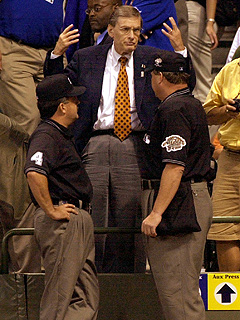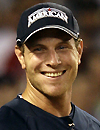The square peg that is the All-Star game and the black hole that is Bud Selig’s idea to make it count for something are back for their ninth year of nonsensical commingling. There is no worse rule in baseball. It rivals the BCS for the most illogical thing in sports.

From this exasperated gesture by Bud Selig at the 2002 MLB All-Star game was born one of the worst rules in sports.
How the stupidity has survived almost a decade never fails to blow the mind. Home-field advantage in the World Series is a significant prize owed to the team that best survived the 162-game season. It is instead given to the team that emerges from the league lucky enough to prevail in an exhibition game managed by the same precepts and principles as a Little League contest.
It should not work both ways. If managers want to hand out the equivalent of participation trophies, the game should not count. If baseball wants the game to mean something, managers should stick with the best players – pitchers especially – for as long as necessary.
Absent direct orders from Selig, that won’t happen. And Selig won’t do bupkis. Already he’s seen as too much of a puppeteer. The game “counts” because overmanaging led to the 2002 tie, which led to the classic pose of Selig (pictured at right), hands in air, clueless as to what to do, which led to the overreaction of bringing some supposed meaning to it.
The new-and-improved, counts-for-something All-Star game posted its worst TV rating ever last season. While TV isn’t all that matters, it’s enough of a barometer to show that the gimmick isn’t driving any interest.
So many better tweaks exist. They might not cause the ratings to spike, but they will give fans a superior experience, and, really, that’s the point of All-Star games: to reward viewers with a night full of great duels, of odd-yet-cool double-play combinations, of the sport’s best getting together on the field.
Baseball’s All-Star game is the best of the four major sports’, and it’s not really close. And it would be even better if Bud Selig would just …
1. Cancel home-field advantage, for goodness sake. Look, it was a nice idea. Honestly. It showed Selig’s ability for novel thinking. It’s easy to appreciate that in a commissioner.
At the same time, a leader is only as good as his ability to recognize faults and flaws, and the home-field arrangement falls squarely into that category. Selig’s insistence on its inclusion in collective bargaining has kept it around, according to sources. Home field brings no true meaning to the game. It is a talking point, a red herring to make Bud Selig look like a man of action. Know what makes him a man of action? Challenging Frank McCourt in bankruptcy court to stand up for the other 29 owners. All-Star game home field is a bankrupt idea.
Think of it this way: If the game counts for something, winning should be the imperative. If it demands a representative from each team – more on that later – that player should be able to contribute something beyond wearing a uniform. Which prompted Mark Carman, a Kansas City radio host, to ask a really good question.
As well as Aaron Crow(notes) has pitched … and as nice a season as Alex Gordon(notes) has had … if Ron Washington is charged with winning the game, surely it would be nice to store on his bench full of superstars perhaps the fastest player in the game. If it is tied in the ninth inning and the AL needs a run, Dyson is a no-brainer pinch runner: sprinter’s speed, 18 for 19 in his career stealing bases – the perfect bench player.
Of course, Dyson is nothing more than that – he’s back at Triple-A right now – and the fact that his participation actually makes sense goes against the spirit of a game that’s supposed to be populated by All-Stars. By proxy, Selig’s doggedness that the game must count is likewise off.
If he wants deep-down, good competition, Selig doesn’t need to throw out a nebulous reward that won’t be realized for another 3½ months. He should just …
2. Pay players a bonus for making the All-Star team. Yeah, yeah. The millionaires don’t need any more money. Hear me out.
With a $100,000 participation bonus, it’s enough money to make players relish their All-Star berth. ForAlex Avila(notes), the AL’s starting catcher making a little more than $400,000, it’s a fantastic bonus. And forAlex Rodriguez(notes), raking in $32 million, it’s a nice opportunity to reward a charity, or maybe commission another centaur self-portrait.
Baseball would reward the game’s MVP with an additional $500,000 bonus – a significant amount for anyone and something that would do a lot more to ensure hard, strong play. Already baseball’s All-Star game features more meaningful action than the other three major sports’ combined. The half-million-dollar bonus – which could be funded equally by MLB and the union, per the collective-bargaining negotiations going on at this moment – would add up to $6.5 million total because …
3. MLB needs to trim the fat from the rosters and take them back to 30. It’s still bigger than they ought to be, but it’s a necessary compromise if they’re going to keep one representative from every team.
And that’s the plan. I thought about this. Not just a cursory one, either. I asked colleagues. I asked people on Twitter. I asked ballplayers. The opinion is divided – almost evenly. Ultimately, it comes down to this: Every-team representation counterbalances ballot-box stuffing by bigger markets as well as oversights by players, coaches and managers. Enough people from underrepresented teams watch the game hoping for their team’s representative to get a plate appearance or pitch an inning that losing those fans would not be worth the gain in what amounts to an exhibition.
The roster breakdown would be as follows:
• Each team would have 12 pitchers. Fans would pick three starters and two relievers, adding a wrinkle to All-Star ballots that today don’t include pitchers.
• Each team would have 17 position players. Fans would pick nine starters for the AL and eight for the NL.
• Players, coaches and managers would choose the remaining participants: five starting pitchers, two relief pitchers, one catcher, one first baseman, one second baseman, one shortstop, one third baseman, two outfielders and the remaining position player with the highest individual vote total (two in the NL). It would end the inherent conflict of interest whereby managers hand-pick the end of their rosters. While a good argument can be made for Bruce Bochy choosing any of the three Giants starters he did this year, bringing on all of them when Tommy Hanson(notes), Jordan Zimmerman, Anibal Sanchez(notes) and others remained off the final list smacked of nepotism.
• The player vote would determine the representative from each team. If one position happens to be overrepresented, it then would be the manager’s discretion to choose one player and target the snubbed player’s teammate with the next-highest vote total. Yes, players would get fleeced by this method, but if one was passed over by fans and peers in the first place, he ought not complain.
• Anyway, the best snubs can gather in a 10-man Final Vote in each league. MLB dreamt up a great idea; no need to get rid of it.
• Each team would have 17 position players. Fans would pick nine starters for the AL and eight for the NL.
• Players, coaches and managers would choose the remaining participants: five starting pitchers, two relief pitchers, one catcher, one first baseman, one second baseman, one shortstop, one third baseman, two outfielders and the remaining position player with the highest individual vote total (two in the NL). It would end the inherent conflict of interest whereby managers hand-pick the end of their rosters. While a good argument can be made for Bruce Bochy choosing any of the three Giants starters he did this year, bringing on all of them when Tommy Hanson(notes), Jordan Zimmerman, Anibal Sanchez(notes) and others remained off the final list smacked of nepotism.
• The player vote would determine the representative from each team. If one position happens to be overrepresented, it then would be the manager’s discretion to choose one player and target the snubbed player’s teammate with the next-highest vote total. Yes, players would get fleeced by this method, but if one was passed over by fans and peers in the first place, he ought not complain.
• Anyway, the best snubs can gather in a 10-man Final Vote in each league. MLB dreamt up a great idea; no need to get rid of it.
For now, 30 men seems fair. Eventually, it could be even less, especially with …
4. The starting lineup mandated to play at least five innings and the starting pitcher required to go at least four. The pitching change is the big one. A few position players a year make it through the fifth, sometimes the sixth. Starters are lucky if they go two innings.
Which is crazy, of course. If these are the best pitchers from each league, matching them up against the lineups people want to see provides the ultimate All-Star experience.
There should be a failsafe, of course. A good starting place: If before the end of the fourth inning a team goes down three runs, or if it’s down two with two runners on base, the manager can yank the starter. No sense in watching a pitcher get Clemens’d.
This makes the position of All-Star starter – which the manager would get to determine – eminently important. He’s the pitcher most capable of winning the MVP award and bonus. Gravitas returns to the position, rather than rendering it a two-inning stint that, by the end, nobody even remembers. Between this and …
5. Giving starters who pitch Sunday a choice whether to play, the pool of potential aces grows – and it prevents the watering down that’s gotten even worse with the rule that bans them from pitching.
Because of this, we’re not going to see Justin Verlander vs. Roy Halladay(notes), the matchup everyone wants. Josh Beckett(notes) vs. Halladay isn’t chopped liver, of course, but Verlander’s dominance this season has been something to behold, and by rule his start this Sunday scratches him from the game.
Never mind that pitchers throw a bullpen session between every start and this could serve as Verlander’s. The choice would be Verlander’s, in consultation with his team. If Verlander wanted to go and Detroit said no, it’s ultimately the player’s decision. He might face questions about his commitment, but at least the choice is his.
Verlander has started an All-Star game before. Granted, it was …
6. The Futures Game, which really needs to be moved to Monday. Some of baseball’s greatest growth in the past decade came via fans embracing prospects. Showcasing the minor leagues’ best talent two days before the actual game exposes them to a far smaller audience than necessary.
Already the Home Run Derby is a hot ticket. Why not precede it with the Futures Game and turn the day into a bonanza? More eyes on young talent breeds familiarity, and the idea of seeing a star before he was a star resonates greater than ever. The Futures Game is a great idea that lacks oomph. Baseball could fix it the same way NBC does a struggling show: stick it next to a marquee attraction.
And imagine the hoopla if …
7. Players used metal bats in the Home Run Derby. The entire point of the derby is to see ridiculous players do ridiculous things. Seeing them do so with ridiculous implements only would add to the enjoyment factor.
Let’s be honest: The two greatest derbies of all time were 1999, when a juiced-up Mark McGwire was hitting balls to Brookline, and 2008, when Josh Hamilton was peppering the upper deck at Yankee Stadium. What did they have in common? Crazy-long home runs. Eventually, we get numb to the number. Bobby Abreu’s(notes) 24-homer barrage in the 2005 derby got monotonous. The prospect of mountain-clearing home runs whets anyone’s appetites, and if the performance enhancement comes from the bat, so be it.
Perhaps a bat company can pay a share of the players’ bonuses in the All-Star game to have its distinctive ping ring throughout the derby. It’s novel, and it may not work, but it’s surely worth a try when the derby has started to resemble the slam-dunk content in its ability to turn stale faster than frat-party beer.
In the absence of metal, the best way to bring life to the event is …
8. For Wily Mo Pena(notes) to participate in the Home Run Derby. Now, it does not look likely. Under the new format, team captains get to pick their three teammates. Prince Fielder(notes), the NL captain, reportedly is leaning toward Dodgers outfielder Matt Kemp(notes), Diamondbacks outfielder Justin Upton(notes) and his Brewers teammate, second baseman Rickie Weeks(notes).
Put yourself in Fielder’s place and it’s easy to understand why he’d choose them. Kemp leads the NL with 22 home runs. Upton hits some of the longest home runs in the game and is playing at home. Weeks is Fielder’s teammate.
Still, a derby without Wily Mo just doesn’t seem right. The timing is too fortuitous. In the season MLB opens up the derby to non-All-Stars, the hardest-hitting man in baseball comes to the major leagues after a 2½-year absence and bops five home runs in 39 at-bats for the team that’s hosting the game. Wily Mo doesn’t need a metal bat to hit balls 500 feet. He would steal the damn show.
Even if the chances are slim, I’m not giving up on this one. I started a Twitter hashtag: #wilymo4derby. I know how Twitter works. The likelihood of getting this to trend over Justin Bieber’s latest haircut is minimal. But if it did. And if Prince Fielder heard about it. And if the movement took off.
Well, forget No. 7 then and just book Wily Mo every year, like the NBA did with Craig Hodges and the 3-point shootout, and enjoy the show. The kids certainly would, because heaven knows they can’t enjoy the regular game unless MLB decides to …

Bud Selig
9. Start the All-Star game earlier. The first pitch is thrown around 8:50 p.m. ET. One more time: 8:50 p.m.
Now, I understand Fox’s need to sell advertising. That comes from the rights fees that MLB demands for programming. And if MLB started the game an hour earlier, the prime-time dollars Fox would land via the advertising simply wouldn’t be there.
Baseball has vowed to start World Series games earlier. It’s a logical step to do the same with the All-Star game, one of its jewel events. If it costs a few million dollars a year, so be it. This is a $7 billion business with revenue streams out the wazoo. It can scratch together a few dollars elsewhere.
MLB has a tremendous opportunity right now. The NFL is locked out. So is the NBA. The NHL may soon have a work stoppage as well. Baseball can grow its fan base by doing things for the fans, and another of those is not mistaking them for doofuses who would be mad at Bud Selig if he’d just …
10. Cancel home-field advantage, for goodness sake. It’s time. The jig is up. Even with one historic franchise in bankruptcy and another teetering on the financial edge, and even with the usual behemoths atop the standings, and even with Wily Mo probably missing the derby – one last time: #wilymo4derby – baseball’s got a whole lot of good going for it.
Someone is going to stroke a game-winning hit on July 12, and he’s going to celebrate with his teammates not knowing whom it will benefit. There’s little pride to be taken in blind accomplishment.
Five hundred grand for helping win a game with no bearing on anything, on the other hand? Now that’s something to be proud of.



No comments:
Post a Comment